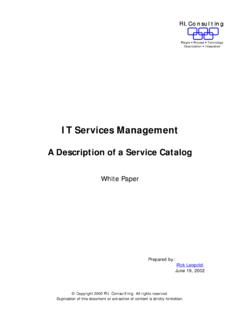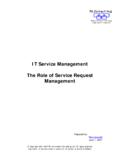Transcription of ITIL v3 Incident Management Process - Nissen …
1 Incident ManagementITIL v3 Incident Management normal service operation as soon as possibleIncident ManagementContent Key definitions Incident Lifecycle Purpose and Objectives Value to business Incident Priority Incident Priority and Target resolution times Major Incidents Escalationas Hierarchical & Functional Standard Incident Models Process Workflow Process Interfaces Information Management Challenges Risks Critical success factors (CSF) Key Performance Indicators (KPIs) Roles and ResponsibilitiesIncident ManagementKey definitionsIncident unplanned interruption to an IT service reduction in the quality of an IT service failure of a CI that has not yet impacted an IT service ( Redundant component failure)Service RequestFormal request from a user for something to be a request for information or advice; to reset a password; or to install a workstation for a new NOT a disruption to the agreed service .. Request Fulfilment Process . Manages lifecycle of Service RequestsWorkaroundMethod of bypassing an Incident or Problem (temporary fix).
2 * It is not a permanent solutionbut something that is used to get the service up and running till the real solution is found. Incident ManagementIncidents have a Lifecycle!.. Life y le is the series of changes that happen to a living creature/project/product/etc. over the course of its lifetime. Status codes indicate where Incidents are in relation tothe lifecycle. : Open In progress Resolved Closed (Pending).. Incident Management is the Process responsible for managing the lifecycle of all progressResolvedClosedIncident ManagementIncident Management is like fire-fighting! Incident ManagementPurpose and normal service operation as quickly as the adverse impact on best possible levels of service quality and availa ility are ai tai ed a ordi g to SLA sObjectives standardized methods and procedures increased visibility and better communication priorities aligned with business user satisfaction with the quality of IT ManagementValue to businessValue to business reducing service downtime reducing Incident impact to business aligning IT to business priority identify possible improvements to service identification of additional requirements( training, new service) as a result of handling multipleincidents.
3 * Value of IM is highly visible to the business. For this reason, IM is often one of the first processes to be implemented in Service Management ManagementIncident assigned, to ensure that the support groups will pay the required attention to the Incident ..based on the Urgency and priorityHow fast does it need to be fixed?How much damage, if not fixed soon?IMPACT+ URGENCY = PRIORITYI ncident Management must be agreed for all Incident -handling stages based upon the overall Incident response and resolution targets within SLAs captured as targets within OLAs and Underpinning Contracts (UCs). support groups should be made aware of these timescales. Service Management tools automate timescales and escalate as requiredExample of priority coding system:HighMediumLowHigh123 Medium234 Low345 URGENCYIMPACTP riority codeDescriptionTarget Resolution Time1 Critical1 hour2 High8 hours3 Medium24 hours4 Low48 hours5 PlanningPlannedIncident Priority & TimescalesIncident priority& TimescalesIncident ManagementMajor Incident = High Impact+ High category of impact for an Incident .
4 Resultsinsignificant disruption to the have separate procedureA separate procedure!!!( for major incidents).. shorter timescales and greater separate major Incident team under the direct leadership of the Incident Informing Management and e Desk ensures that all activities are recorded and users are kept fully informed of IncidentsMajor IncidentIncident ManagementHierarchical take place at any moment during resolution. Reasons might be: SLA threat Extra resources required Need to inform Higher managementFunctional means involving more specialist personnel or access privileges to solve the Incident . Departmental boundaries may be exceeded. 2ndLineSupport Team3rd LineSupport TeamService DeskManagerService DeskSupport Team3rdLineManager2ndLineManagerIT ServiceManagerFunctional (competence)Hierarchical (authority)Functional and Hierarchical EscalationEscalationEscalationis the mechanism that assists timely resolution of an Incident . Incident ManagementStandard Incident modelsStandard Incident ModelsStandard Incident Models are designed and implemented for handling standard (reoccurring) incidents more Incident Model should include the following: steps required to handle the Incident and theirorder Responsibilities Ti es ales a d thresholds for completion A LJ es alatio pro edure A LJ e ide e pre e tio a ti tools can then be used to automate handling of standard ManagementProcess WorkflowIncident ManagementTRIGGERS:Incidents.
5 From Event Mgmt, from web interface, from Users, from suppliers, from technical StuffIncident Identification: UsuallLJ it s u a epta le to ait u til a user logs a i ide t Monitoring assures : Early detection of Failure/potential failure Quick start of Incient Management *IDEAL SITUATION: Incident is resolved before it had an influence on users ! Process Workflow Incident IdentificationIncident Management All incidents must be fully logged (INC. NO., DATE, TIME, OWNER, ) .. and date/time stamped; Full historical record of all incidents must be Opportu itLJ fid es ust also e logged !!! ALL ust e logged * Incident is logged -> Resolution time count starts ! Process Workflow Incident LoggingIncident Management Categorization indicates the type of Incident being logged*Category is often related to team that will handle the Incident from the Service Desk*Categories are often multi-level . For Example:-Hardware Server Memory Board Card Failure-Software Application Finance Suite Purchase Order System*It s useful if i ide t a d pro le ategories are alikeProcess Workflow Incident CategorizationIncident Management A part of categorisation will be to check if it s a Se vice Re uest If it is ->It will be transferred to Request Fulfilment Process *Requests are not incidents and should be handeled diferently Process Workflow Service Request?
6 Incident Management Prioritisation determines how the Incident will be handled by support staff and by support tools * Remember: PRIORITY = Urgency + Impact (+ SLA) HighMediumLowHigh123 Medium234 Low345 URGENCYIMPACTP riority codeDescriptionTarget Resolution Time1 Critical1 hours2 High8 hours3 Medium24 hours4 Low48 hours5 PlanningPlannedProcess Workflow Incident PrioritizationIncident Management If priority indicates Major Incident it must be handled by following the Major Incident Procedure* Staff must be familiar with the procedure ! Process Workflow Major Incident ? Incident Management Service Desk Analyst will determine with the user: Full symptoms (what has gone wrong) How to correct it ? Using: Diagnostic scripts Known Error informationIf the Incident is resolved -> it will be closed (after informing the user !!!) Process Workflow Incident DiagnosisIncident ManagementIf the Incident is NOT resolved -> it will be escalated (and user informed !!!) FUNCTIONAL ESCALATION (to the next level of support) occurs when: Current level of support can t esolve the Incident Current level of suppot has reached time scales for resolving the Incident * Ownership of the Incident stays with the Service Desk!
7 * Service Desk will track and monitor progress ! Process Workflow Functional EscalationIncident ManagementIf the Incident is NOT resolved -> it will be escalated (and user informed !!!) HIERARCHIC ESCALATION (up the Management chain) occurs when: SLA breaches are threatened Extra resources are needed to resolve the Incident Senior Management needs to be aware / approve the steps required* May also be initiated by the customer / user if they see it necessary ! Process Workflow Hierarchical EscalationIncident Management More detailed information might be collected on: Exactly what has gone wrong Understanding the chronological order of events Confirming the full impact Identifying events that may have triggered the Incident Knowledge searches Previous incidents Changes made* All actions and finidings must be recorded !*As much actions as possible should be performed in parallel to save time Process Workflow Investigation & DiagnosisIncident Management When the resolution has been identified it should be applied and tested If satisfactory a time / date stamp is recorded as this is the end of downtime The Incident record must be updated with the details of actions taken The Incident should be returned to the Service Desk for closure actionProcess Workflow Resolution and RecoveryIncident Management Before closing the Incident the SD Analyst must: Make sure the user is informed and happy with the solution The assigned Incident category is the correct one (if not , correct it) The Incident documentation is complete If there is indication the Incident might recur, a Problem record should be raised * The Incident is closed by Service Desk !
8 *Re-opening incidents strict rules must exist for this action !!! Process Workflow Incident ClosureIncident ManagementProcess InterfacesEvent Mgmt Event can (automatically) raise Incident Request Fulfilment Request handling can also be handled by IM processProblem Management Incidents (repeated) often point to problems Solving the problems should reduce the number of incidents Asset & Configuration Mgmt Provides data used to identify and progress incidents IM assists in verfication of CMSC hange Management Changes are often reasons why incidents occure Incidents can lead to changes required for resolutions/workarounds Incident ManagementProcess Interfaces Level Management IM must restore service as agreed in SLAs thus, targets for IM are determined considering SLM and vice-versaService Catalogue Management Service Dask will consult Service Catalogue in handling incidents Capacity Management IM may trigger monitoring of a system or service performed by Capacity Management Workarounds used by Incident Management can come from Capacity ManagementAvailability Management Incident data is important in determining availability.
9 Incident ManagementCMDBCMSI ncident Record Reference Number CI Impacted Dates and Times Originator Affected users Symptoms Category, Priority Actions Taken Relationships Closure detailsDiagnostic ScriptKEDBI nvolvement in Information ManagementIncident Management Ability to detect incidents as early as possible. Convincing all staff that ALL incidents must be logged. Making information available about known errorsto ensure staff learn from previous incidents. Configuration Management System integration Integration into the Service Level Management processesin order to correctly assess the impact and priority of incidents, and Defining escalation Management Incidents not being handled in appropriate timescales Insufficient Incident backlog Poor information availability (for ) Mismatch inobjectives/expectations for Incident to a lack of or inappropriate training ?..due to inadequate support tools ?..due to lack of support tools integration ?..due to poorly-aligned or non-existent OLAs or UCs.
10 SLAs ?..due to .. ?RisksRisksIncident Management CSF Resolve incidents as quickly as possible minimizing impacts to the business KPI Mean elapsed time to achieve Incident resolution or circumvention, broken down by impact code KPIB reakdown of incidents at each stage ( logged, work in progress, closed etc.) KPIP ercentage of incidents closed by the service desk without reference to other levels of support (often referred to as first poi t of o ta t ) KPI Number and percentage of incidents resolved remotely, without the need for a visit CSF Maintain quality of IT services KPI Total numbers of incidents (as a control measure) KPISize of current Incident backlog for each IT service KPI Number and percentage of major incidents for each IT service CSF Maintain user satisfaction with IT services KPIA verage user/customer survey score (total and by question category) KPIP ercentage of satisfaction surveys answered versus total number of satisfaction surveys sentCritical Success Factors (CSF) & Key performance Indicators (KPI)CSF & KPI ExamplesIncident ManagementIM Process Owner - accountable for the Process Incident Manager.







